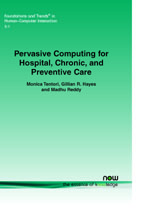Pervasive Computing for Hospital, Chronic, and Preventive Care
By Monica Tentori, CICESE, Mexico, mtentori@cicese.mx | Gillian R. Hayes, University of California, USA, gillianrh@ics.uci.edu | Madhu Reddy, The Pennsylvania State University, USA, mreddy@ist.psu.edu
Abstract
An emerging area of great impact and significance is the application of pervasive computing technologies in healthcare. Pervasive healthcare refers to the set of technologies designed to seamlessly integrate health education, interventions, and monitoring technology into our everyday lives, regardless of space and time. This approach can increase both the coverage and quality of care. Over the last decade, pervasive computing solutions for healthcare have become increasingly prevalent in both research and commercial efforts. This survey analyzes a variety of research projects and commercial solutions devoted to understanding, designing, and implementing pervasive healthcare applications in support of preventive care, hospital care, and chronic care.
Taking into account the working conditions of clinicians and the needs of patients, pervasive computing offers a variety of attractive solutions for many of the challenges to care delivery in these domains. The work of clinicians is intrinsically tied to the physical domain of the patient, not to digital material available in computer systems; clinicians as well as other non-clinical caregivers continually switch between different caregiving contexts. Furthermore, their work is characterized by high mobility, ad hoc collaboration, and interruptions. At the same time, patients and family members frequently demonstrate poor adherence to both behavioral and pharmaceutical interventions and experience inadequate communication with those providing care. The use of health education to promote motivation, reinforcement, advice, and tools for capturing and tracking health information supporting self-monitoring can help patients to overcome these challenges. Pervasive computing offers solutions for clinicians, patients, and a variety of other caregivers to assist them with these problems including applications and mechanisms to:
- ease the recording, tracking, and monitoring of health information;
- allow communication, collaboration, and coordination among the varied stakeholders;
- encourage clinical adherence and disease prevention;
- support the nomadic work of clinicians and seamless integration of the physical and digital worlds; and
- enable the development of novel medical devices.
Pervasive Computing for Hospital, Chronic, and Preventive Care
Pervasive healthcare refers to the set of technologies designed to seamlessly integrate health education, interventions, and monitoring technology into our everyday lives, regardless of space and time. This approach can increase both the coverage and quality of care. Pervasive Computing for Hospital, Chronic, and Preventive Care discusses close to 150 projects from the academic and commercial domains to present a detailed overview of the state of the art in pervasive healthcare research. It portrays a human-centered vision driven by a healthcare model devoted to the design and implementation of pervasive computing in support of: hospital care, to provide clinicians with access to relevant information from anywhere within the hospital through a variety of heterogeneous devices using context-aware information systems, note-taking applications, and hospital collaborative applications; chronic care, to support chronic care management and aging in place through solutions supporting real-time monitoring, step-by-step guidance, assisted navigation, and social connectedness; and preventive care, to support physical and psychological well-being using capture and access applications, persuasive technologies, and social health. This monograph closes by discussing and outlining some of the open challenges and new trends for future research in pervasive healthcare
